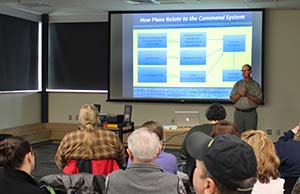
This fall, the council sponsored a series of community workshops to teach citizens how an oil spill response is organized and managed.
The workshops in Homer, Whittier and Seward examined the power and decision making structure used during an emergency, and the role of federal, state, and local responders, and the role of the communities in the system. The goal was to help communities understand how to be more effective in representing themselves during an incident and understand more about how a spill would be handled.
Topics covered included:
- Basics of the Incident Command System, a standardized incident management system that is used to respond to all types of hazards and emergencies
- Laws that affect oil spill response
- The prevention and response system in place for the Prince William Sound shipping trade
- How community interactions with Unified Command occur
Participants included representatives from the oil and tourism industries, government agencies, elected officials, and other concerned citizens. Steve Russell, who is the State representative for South Central vicinity incidents from the Alaska Department of Environmental Conservation was on hand at each of the workshops to help answer questions.